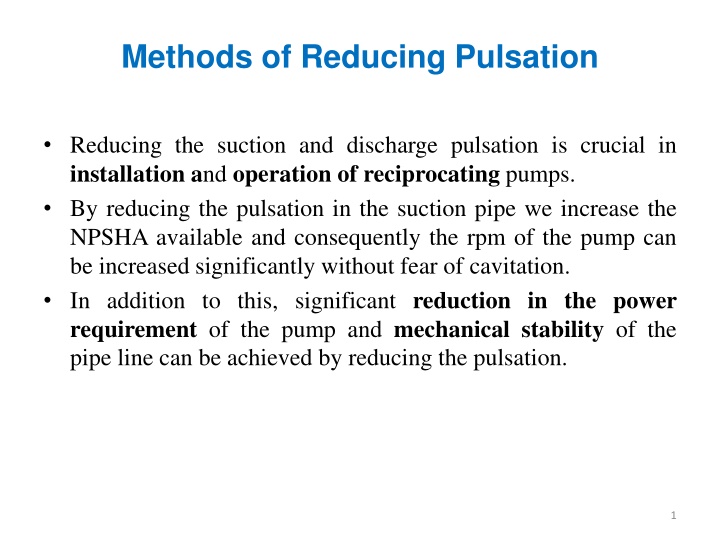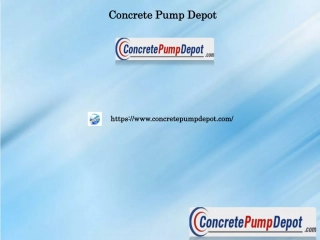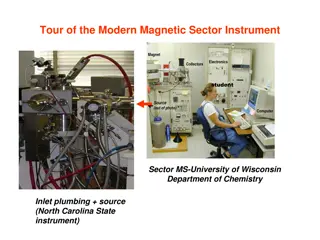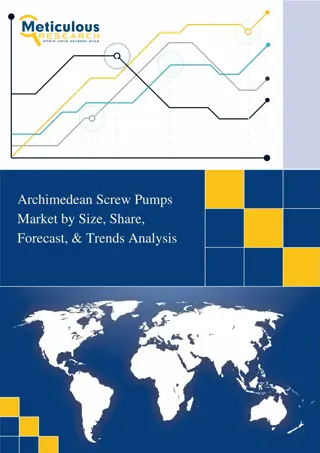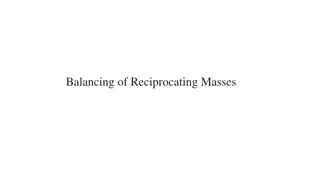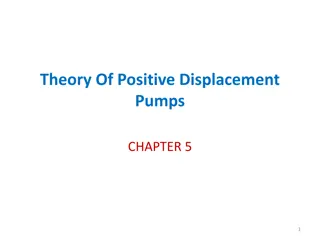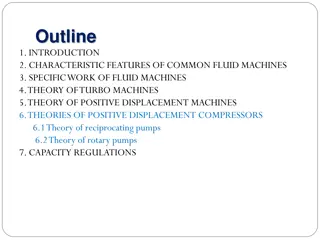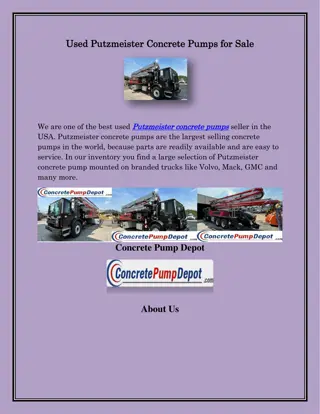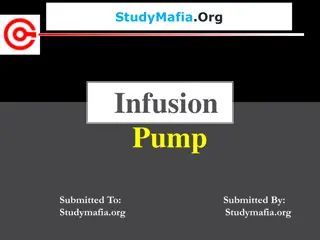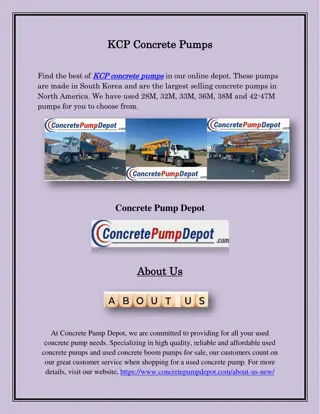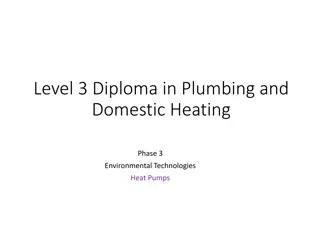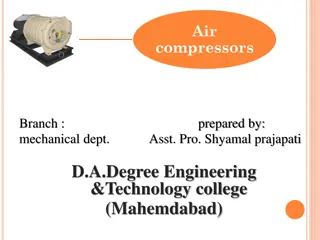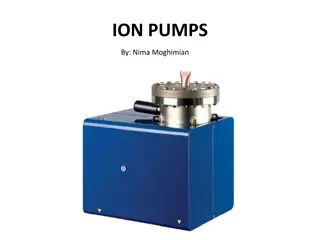Methods for Reducing Pulsation in Reciprocating Pumps
The reduction of suction and discharge pulsation is crucial for the proper operation of reciprocating pumps. By minimizing pulsation, benefits such as increased NPSHA, enhanced mechanical stability, and reduced power requirements can be achieved. Various methods like using multiplex pumps and air chambers help in minimizing pulsation effects, ensuring optimal performance and longevity of the pump system.
Download Presentation

Please find below an Image/Link to download the presentation.
The content on the website is provided AS IS for your information and personal use only. It may not be sold, licensed, or shared on other websites without obtaining consent from the author.If you encounter any issues during the download, it is possible that the publisher has removed the file from their server.
You are allowed to download the files provided on this website for personal or commercial use, subject to the condition that they are used lawfully. All files are the property of their respective owners.
The content on the website is provided AS IS for your information and personal use only. It may not be sold, licensed, or shared on other websites without obtaining consent from the author.
E N D
Presentation Transcript
Methods of Reducing Pulsation Reducing the suction and discharge pulsation is crucial in installation and operation of reciprocating pumps. By reducing the pulsation in the suction pipe we increase the NPSHA available and consequently the rpm of the pump can be increased significantly without fear of cavitation. In addition to this, significant reduction in the power requirement of the pump and mechanical stability of the pipe line can be achieved by reducing the pulsation. 1
In a process where uniform discharge is required, either the discharge pulsation should be reduced or eliminated somehow or other type of pumps should be used. The other major problem related to discharge pulsation is mechanical instability. Due to the non-uniformity of velocity of the liquid in the cylinder and the discharge pipe the liquid will decelerate. This deceleration causes pressure pulsation, which in some cases cause serious mechanical instability. The following section discusses the methods for reducing pulsation in reciprocating pumps. 2
a. Using multiplex pumps Using multiplex pumps with the cylinder connected in parallel and the piston actuated by common crankshaft reduces pulsation significantly. Figure 5.6 A multiplex (triplex) reciprocating pump 3
40 35 30 25 20 15 10 5 0 0 60 120 180 240 300 360 -5 Figure 5.7 Reduction of pulsations due to multiple cylinders 4
Table 5.2 Effect of number of piston/cylinder on variation in capacity Type Number of % Above %Below Piston phase pistons mean mean Duplex 2 24 22 1800 Triplex 3 6 17 1200 Quadraplex 4 11 22 900 Quintaplex 5 1 5 720 Sextplex 6 5 9 600 Septuplex 7 1 3 51.50 v v v v = min mean = % 100 % below mean max mean % 100 % above mean v v mean mean 5
b. Air Chambers in the suction and Discharge lines Air vessels are closed cylindrical vessels for storing excess flow. Towards the middle of the stroke, when the velocity of the flow is greater than the average, the excess flow gets into the air vessel and compresses the air in the cylinder, building up a pressure higher than the atmospheric pressure. Air chambers Air Liquid Figure 5.8 Air chambers in reciprocating pumps 6
Towards the end and the beginning of the next stroke, when the velocity is low, the liquid under pressure in the air vessel is pushed back to the delivery or suction line depending on whether the stroke is delivery or suction stroke, thus increasing the velocity there to the average value. The only liquid which is accelerated is that between the air vessel and the cylinder. When the volume of air in the chamber is large enough, the flow velocity in the suction pipe is nearly constant. The suction pulsation in the valve chest is offset by the variable rate of liquid flow from the air chamber. 7
The Average Volume of Air in The Chamber The amount of air in the air chamber is an important parameter that determines the uniformity of the flow in the pipe line section above which it is installed. While the pump is working the air in chamber gets compressed and expanded and occupies corresponding volumes, indicated as Vmin and Vmax respectively (Figure 5.9). When the volume of the air is minimum its pressure is maximum and vice versa. When the pump is not working it takes the middle position as indicated in Figure 5.9. 8
Air Vmin Top level Vmax Middle level Bottom level Figure 5.9 Air vessel The calculation of the average volume of air is based on the excess volume of liquid that should be handled by the air chamber and the, and isothermal expansion and compression of the air in the chamber. As can be seen from Figure 5.9 , the excess volume of liquid that should be drawing into the chamber and delivered during each cycle is the difference between Vmax and Vmin. Therefore, = Vexcess V V max min 9
Determining the Excess Volume It is already shown that the capacity of a reciprocating pump depends on the crank angle. The relation between the crank angle and the capacity for harmonic motion is equal to the product of the area of the piston head and the velocity of the piston head. The velocity of the piston head is given by. = sin R Q A p 10
The average capacity does not depend on the crank angle and Figure 5.10 is a typical representation of the actual and average volume flow rates as function of time for one complete rotation, i.e. between 00and 3600. The area under each of the curves represents the total volume to be delivered by the pump in one complete rotation of the crank (one suction and one discharge stroke). The two areas should be equal, since whether the flow is uniform or not the same amount of liquid is drawn into the pump and is discharged out in every rotation. 11
Excess volume Actual capacity (function of the crank angle) Q Average capacity 00 0.002 900 Figure 5.10 Excess volume 0.004 0.006 00 0.008 t[min] The shaded area above the average volume flow rate represents the volume of the liquid which has a flow rate in excess of the average volume flow rate. The volume of liquid represented by that area should be stored and delivered by the air chamber. = = Area of Shaded Region Vexcess V V max min 12
Hence the volume of the liquid to be stored in the chamber can be computed by drawing the actual and average volume flow rates on the same scale for a time of one complete rotation, and determining graphically the area above the average volume flow rate line (shaded area). 13
Calculating the Average Volume of Air in the Chamber This calculation is based on the assumption that the compression and expansion in the air chamber takes place at isothermal condition. Hence, PV = Const When the air is compressed the pressure is maximum and the volume is minimum and it is vice versa for expansion. Applying the above equation, = max P V P V min min max The performance of the air chamber is characterized by the degree of irregularity which is defined by max = min P P Pav 14
Where Pav is the average air pressure in the chamber, given by + max P P = min Pav 2 P P = max min + ( / ) 2 P P max min P V = max V min P min max V V min min 1 P P max max V V = = max max V V + + min min 2 1 2 P P max max V V max max V V V V = = max min excess = excess V ( ) + 2 V V V average max min average 15
The average volume of air in the chamber can be determined for a predetermined degree of irregularity. Note it is earlier discussed how to determine the excess volume graphically. This procedure is used both for suction and discharge air chambers. The commonly accepted degrees of irregularity are For Suction Air Chambers For Discharge Air Chambers 0.02 0.04 0.05 A calculation based on the above procedure gives the average volume of air in the chamber in terms of the area of the piston and stroke length as given in the table below. 16
Table 5.3 Average Air Volume in Air Chambers Type of Pump Vaverage Single Acting Single Cylinder 27.5 ApistS Double Acting Single Cylinder 10.5 ApistS Single Acting Triplex pump 0.45 ApistS 17
5.2 Theory Of Rotary Pumps Rotary pumps are positive displacement pumps in which energy is transferred to the flow medium by direct application of force on the boundary of the fluid, which is defined by the rotating and stationary elements of the pump. Like reciprocating pumps the amount of fluid displaced by each revolution is independent of speed. The inlet and outlet ports of rotary fluid machines are separated by the action and position of the pumping elements and the close running clearance of the fluid machine. Hence, unlike reciprocating machines rotary machines do not need suction and discharge valves. 18
5.2.1 Operating Principle of Rotary Pumps There are three distinct parts in the any rotary pump that is in operation. These parts are defined by the rotating and stationary parts of the pump and determine the amount of the displaced volume. The first part is defined by the part that is open to the inlet and is sealed from the outlet. The second is the part that is sealed from both the inlet and outlet. The third is the part is the part that is sealed from the inlet but open to the outlet. 19
CTIO OTO OTI Figure 5.13 Parts of Operating Rotary Pumps The three parts are designated as OTI (Open to inlet), CTIO (Closed to inlet and outlet) and OTO (Open to outlet). For a good pumping action the open-to-inlet (OTI)volume should grow smoothly and continuously with pump rotation while the open-to-outlet volume (OTO)should reduce smoothly and continuously. The closed to-inlet and-outlet volume should remain constant with pump rotation. 20
Displacement of Common Rotary Pumps The displacement D of a rotary pump is the total net volume transferred from the OTI to the OTO volume during one complete revolution of the driving rotor. For any given pump, the displacement depends only upon the physical dimensions of the pump elements and the pump geometry and is independent of other operating conditions 21
Displacement of External Gear Pumps Figure . External Gear Pump The displacement D of a gear pump is given by A D 2 = lz identical gears Where -- D= Displacement, A=cross-sectional area of tooth space l=length of gear teeth, z=number of teeth 22
Displacement of Vane Pumps It is used for the determination of the displacement of vane pumps. R1 Discharge Suction R2 Figure Vane pump Minimum and Maximum Radii = 2 2 2 1 ( ) D l R R l=Total axial length of the rotor R1=Minimum radial dimension of the rotor elements R2=Maximum radial dimension of the rotor elements 23
1.Capacity of Rotary Pumps In general the capacity of any rotary pump is the product of its displacement (D), speed of rotation of the drive (n) and the volumetric efficiency ( v). v Dn Q = It is also commonly given as = 1 ( ) Q Dn s Where s = slip of the pump =1- v 24
1.Pressure (Head) of Rotary Pumps Rotary pumps unlike centrifugal pumps can deliver whatever head is required by the system. The only limitations are the power of the drive and the strength of the pump. If the drive can deliver sufficient power, yet if the strength of the pump is low the pump will be damaged. Hence all positive displacement pumps are commonly, fit with relief valves that limits the maximum pressure inside the pump. Another limiting factor for the maximum pressure is the pump slip. The pump slip (leakage) in rotary pumps generally increases with pressure hence running at very high pressure may result in very low efficiency. Note that the total head of the pump is given by:- Where Pt is the total pressure developed by the pump P = t H g 25
1.Power of Rotary Pumps The useful and brake power of a rotary pump are calculated from the total pressure to be transferred to the flow medium, the volume flow rate and overall efficiency of the pump. Useful Power The useful power of a rotary pump is the product of the flow rate and total pressure of the pump (Useful), and is given by, QP N = Brake Power The brake power is calculated from the useful power and the overall efficiency using :- t QP N = t b The overall efficiency of rotary pumps is determined by test 26
5.2.6 Performance Characteristic of Rotary Pumps The performance characteristics of all positive displacement pumps are similar and can be applied to rotary pumps also. For rotary it is also common to present the curves as functions of the total pressure:- Nb= (P ) f = (P ) f Q = (P ) f n[rpm]=constant Viscosity= Constant Q N Plim P Figure 5.16 Performance characteristic of rotary pumps 27
Note that the capacity curve decreases with pressure. This is due to the fact that the volumetric efficiency of rotary pumps in general decreases with the pressure against which the pump is working. The limiting pressure Plim represents the pressure above which there will be rapid wear of the pump. The pump efficiency drops rapidly and hence the power consumption ( brake power) of the pump also grows quickly. The value of the limiting pressure is adjusted by the setting point (limiting pressure) of the relief valve. 28
